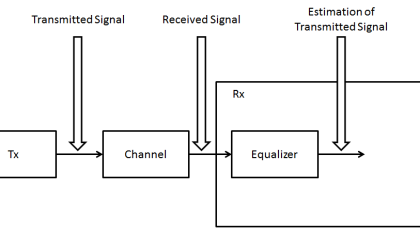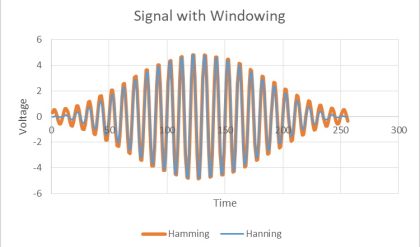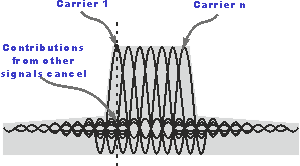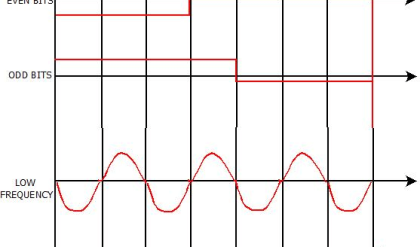Frequency Reuse is the scheme in which allocation and reuse of channels throughout a coverage region is done. Each cellular base station is allocated a group of radio channels or Frequency sub-bands to be used within a small geographic area known as a cell. The shape of the cell is Hexagonal. The process of selecting and allocating the frequency sub-bands for all of the cellular base station within a system is called Frequency reuse or Frequency Planning.
Silent Features of using Frequency Reuse:
· Frequency reuse improve the spectral efficiency and signal Quality (QoS).
· Frequency reuse classical scheme proposed for GSM systems offers a protection against interference.
· The number of times a frequency can be reused is depend on the tolerance capacity of the radio channel from the nearby transmitter that is using the same frequencies.
· In Frequency Reuse scheme, total bandwidth is divided into different sub-bands that are used by cells.
· Frequency reuse scheme allow WiMax system operators to reuse the same frequencies at different cell sites.

Cell with the same letter uses the same set of channels group or frequencies sub-band.
To find the total number of channel allocated to a cell:
S = Total number of duplex channels available to use
k = Channels allocated to each cell (k<S)
N = Total number of cells or Cluster Size
Then Total number of channels (S) will be,

In the above diagram cluster size is 7 (A,B,C,D,E,F,G) thus frequency reuse factor is 1/7.
N is the number of cells which collectively use the complete set of available frequencies is called a Cluster. The value of N is calculated by the following formula:

Where I,J = 0,1,2,3…
Hence, possible values of N are 1,3,4,7,9,12,13,16,19 and so on.
If a Cluster is replicated or repeated M times within the cellular system, then Capacity, C, will be,

In Frequency reuse there are several cells that use the same set of frequencies. These cells are called Co-Channel Cells. These Co-Channel cells results in interference. So to avoid the Interference cells that use the same set of channels or frequencies are separated from one another by a larger distance. The distance between any two Co-Channels can be calculated by the following formula:

Where,
R = Radius of a cell
N = Number of cells in a given cluster
Below is the Python code for visualizing the Frequency Reuse concept
filter_none
brightness_4
| #!/usr/bin/python from math import * # import everything from Tkinter modulefrom tkinter import * # Base class for Hexagon shapeclass Hexagon(object): def __init__(self, parent, x, y, length, color, tags): self.parent = parent self.x = x self.y = y self.length = length self.color = color self.size = None self.tags = tags self.draw_hex() # draw one hexagon def draw_hex(self): start_x = self.x start_y = self.y angle = 60 coords = [] for i in range(6): end_x = start_x + self.length * cos(radians(angle * i)) end_y = start_y + self.length * sin(radians(angle * i)) coords.append([start_x, start_y]) start_x = end_x start_y = end_y self.parent.create_polygon(coords[0][0], coords[0][1], coords[1][0], coords[1][1], coords[2][0], coords[2][1], coords[3][0], coords[3][1], coords[4][0], coords[4][1], coords[5][0], coords[5][1], fill=self.color, outline=”black”, tags=self.tags) # class holds frequency reuse logic and related methodsclass FrequencyReuse(Tk): CANVAS_WIDTH = 800 CANVAS_HEIGHT = 650 TOP_LEFT = (20, 20) BOTTOM_LEFT = (790, 560) TOP_RIGHT = (780, 20) BOTTOM_RIGHT = (780, 560) def __init__(self, cluster_size, columns=16, rows=10, edge_len=30): Tk.__init__(self) self.textbox = None self.curr_angle = 330 self.first_click = True self.reset = False self.edge_len = edge_len self.cluster_size = cluster_size self.reuse_list = [] self.all_selected = False self.curr_count = 0 self.hexagons = [] self.co_cell_endp = [] self.reuse_xy = [] self.canvas = Canvas(self, width=self.CANVAS_WIDTH, height=self.CANVAS_HEIGHT, bg=”#4dd0e1″) self.canvas.bind(“<Button-1>”, self.call_back) self.canvas.focus_set() self.canvas.bind(‘<Shift-R>’, self.resets) self.canvas.pack() self.title(“Frequency reuse and co-channel selection”) self.create_grid(16, 10) self.create_textbox() self.cluster_reuse_calc() # show lines joining all co-channel cells def show_lines(self): # center(x,y) of first hexagon approx_center = self.co_cell_endp[0] self.line_ids = [] for k in range(1, len(self.co_cell_endp)): end_xx = (self.co_cell_endp[k])[0] end_yy = (self.co_cell_endp[k])[1] # move i^th steps l_id = self.canvas.create_line(approx_center[0], approx_center[1], end_xx, end_yy) if j == 0: self.line_ids.append(l_id) dist = 0 elif i >= j and j != 0: self.line_ids.append(l_id) dist = j # rotate counter-clockwise and move j^th step l_id = self.canvas.create_line( end_xx, end_yy, end_xx + self.center_dist * dist * cos(radians(self.curr_angle – 60)), end_yy + self.center_dist * dist * sin(radians(self.curr_angle – 60))) self.line_ids.append(l_id) self.curr_angle -= 60 def create_textbox(self): txt = Text(self.canvas, width=80, height=1, font=(“Helvatica”, 12), padx=10, pady=10) txt.tag_configure(“center”, justify=”center”) txt.insert(“1.0”, “Select a Hexagon”) txt.tag_add(“center”, “1.0”, “end”) self.canvas.create_window((0, 600), anchor=’w’, window=txt) txt.config(state=DISABLED) self.textbox = txt def resets(self, event): if event.char == ‘R’: self.reset_grid() # clear hexagonal grid for new i/p def reset_grid(self, button_reset=False): self.first_click = True self.curr_angle = 330 self.curr_count = 0 self.co_cell_endp = [] self.reuse_list = [] for i in self.hexagons: self.canvas.itemconfigure(i.tags, fill=i.color) try: self.line_ids except AttributeError: pass else: for i in self.line_ids: self.canvas.after(0, self.canvas.delete, i) self.line_ids = [] if button_reset: self.write_text(“Select a Hexagon”) # create a grid of Hexagons def create_grid(self, cols, rows): size = self.edge_len for c in range(cols): if c % 2 == 0: offset = 0 else: offset = size * sqrt(3) / 2 for r in range(rows): x = c * (self.edge_len * 1.5) + 50 y = (r * (self.edge_len * sqrt(3))) + offset + 15 hx = Hexagon(self.canvas, x, y, self.edge_len, “#fafafa”, “{},{}”.format(r, c)) self.hexagons.append(hx) # calculate reuse distance, center distance and radius of the hexagon def cluster_reuse_calc(self): self.hex_radius = sqrt(3) / 2 * self.edge_len self.center_dist = sqrt(3) * self.hex_radius self.reuse_dist = self.hex_radius * sqrt(3 * self.cluster_size) def write_text(self, text): self.textbox.config(state=NORMAL) self.textbox.delete(‘1.0’, END) self.textbox.insert(‘1.0’, text, “center”) self.textbox.config(state=DISABLED) #check if the co-channels are within visible canvas def is_within_bound(self, coords): if self.TOP_LEFT[0] < coords[0] < self.BOTTOM_RIGHT[0] \ and self.TOP_RIGHT[1] < coords[1] < self.BOTTOM_RIGHT[1]: return True return False #gets called when user selects a hexagon #This function applies frequency reuse logic in order to #figure out the positions of the co-channels def call_back(self, evt): selected_hex_id = self.canvas.find_closest(evt.x, evt.y)[0] hexagon = self.hexagons[int(selected_hex_id – 1)] s_x, s_y = hexagon.x, hexagon.y approx_center = (s_x + 15, s_y + 25) if self.first_click: self.first_click = False self.write_text( “””Now, select another hexagon such that it should be a co-cell of the original hexagon.””” ) self.co_cell_endp.append(approx_center) self.canvas.itemconfigure(hexagon.tags, fill=”green”) for _ in range(6): end_xx = approx_center[0] + self.center_dist * i * cos( radians(self.curr_angle)) end_yy = approx_center[1] + self.center_dist * i * sin( radians(self.curr_angle)) reuse_x = end_xx + (self.center_dist * j) * cos( radians(self.curr_angle – 60)) reuse_y = end_yy + (self.center_dist * j) * sin( radians(self.curr_angle – 60)) if not self.is_within_bound((reuse_x, reuse_y)): self.write_text( “””co-cells are exceeding canvas boundary. Select cell in the center””” ) self.reset_grid() break if j == 0: self.reuse_list.append( self.canvas.find_closest(end_xx, end_yy)[0]) elif i >= j and j != 0: self.reuse_list.append( self.canvas.find_closest(reuse_x, reuse_y)[0]) self.co_cell_endp.append((end_xx, end_yy)) self.curr_angle -= 60 else: curr = self.canvas.find_closest(s_x, s_y)[0] if curr in self.reuse_list: self.canvas.itemconfigure(hexagon.tags, fill=”green”) self.write_text(“Correct! Cell {} is a co-cell.”.format( hexagon.tags)) if self.curr_count == len(self.reuse_list) – 1: self.write_text(“Great! Press Shift-R to restart”) self.show_lines() self.curr_count += 1 else: self.write_text(“Incorrect! Cell {} is not a co-cell.”.format( hexagon.tags)) self.canvas.itemconfigure(hexagon.tags, fill=”red”) if __name__ == ‘__main__’: print( “””Enter i & j values. common (i,j) values are: (1,0), (1,1), (2,0), (2,1), (3,0), (2,2)””” ) i = int(input(“Enter i: “)) j = int(input(“Enter j: “)) if i == 0 and j == 0: raise ValueError(“i & j both cannot be zero”) elif j > i: raise ValueError(“value of j cannot be greater than i”) else: N = (i**2 + i * j + j**2) print(“N is {}”.format(N)) freqreuse = FrequencyReuse(cluster_size=N) freqreuse.mainloop() |

OUTPUT:






Comments are closed.